The Museum of Art Collections
Bucharest is home to many treasures that the general public is unaware of.

Christine Leșcu, 16.11.2013, 14:06
Some of the art collectors, though, chose to reveal these treasures and even put them on display at the Museum of Art Collections in Bucharest. Located in downtown Bucharest, on the famous Victoria Boulevard, known in the old days as the Mogosoaia Bridge, the Museum stands surrounded by an eclectic entourage.
Next to it there stands the Romanian Academy, hosted by a sumptuous building inaugurated in 1989. Right across the street one can see the modernist, inter-war building of the Economy Ministry. The Museum of Art Collections is hosted by one of the oldest mansions in Bucharest. Dana Dragomir, the coordinator of the museum, told us a few things about the history of this building.
“The Museum of Art Collections is hosted by the Romanit Palace, whose construction started in 1822 and lasted four years. It looked rather sumptuous back then, although it only had the central body. It was the property of Grigore Romanit, a Greek boyar who was very rich in early 19th century. In time, though, he lost his fortune and started renting the palace for the balls that were organized back then. That happened until 1850. After that, the palace repeatedly changed its owners, but none of them could afford to maintain it. In 1884 it was taken over by the Finance Ministry. It was then that two wings were added to the building.”
Right in front of the central body, between the two lateral wings, there is a fountain surrounded by a small green area, a genuine oasis in the middle of a busy capital. In August 1978, the building became home to the Museum of Art Collections, as part of the National Museum of Art. In the beginning the museum only had 13 collections, donated to the state by their previous owners. They were famous collections at the time, made up of pieces of furniture, crystals, ceramics, ivory and china. Of course the museum also has paintings, sculptures and graphic works, as Dana Dragomir explained.
“One of the first collections was that put together by Dr. Iosif Dona, the first spa physician in Romania, who lived in the early 19th century. Another important collection is that of violin teacher Avachian, which had been compiled by himself and his cousins Beatrice and Hrandt Avachian. The charm of these collections lies in the fact that they are very unitary, showing the collectors’ taste. For instance, the Zambaccian collection, one of the first collections hosted by the museum, is famous for its Romanian and French impressionist paintings. We also have the Iosif Iser memorial collection, which includes paintings made by Iser himself, as well as other items such as Bohemian crystals, china objects and rugs. The collections create a very pleasant universe and allow viewers to get a glimpse of the every day life of a painter, for instance. This is something that we are trying to do at the museum, namely to recreate that atmosphere that each collector lived in.”
Some of the collections include items that are highly valuable. Dana Dragomir again:
“Doctor Mircea Petrescu’s collection, for instance, includes a Henry II table, highly appreciated by art critics. Also, there are some masterpieces such as paintings by Nicolae Tonitza and Nicolae Grigorescu. It’s worth mentioning that most collectors were interested in Romanian paintings. That is why our museum can be seen as a place where the history of Romanian modern art has been recreated, starting with Theodor Aman up to the interwar period.”
The year 1986 saw the beginning of a long restoration process. One of the wings of the museum was closed and it was only renovated in 2003. In 2009 the whole museum was closed down, to be reopened this year. The museum is now hosted by a modernized building, where all the items can be properly stored. The number of collections has also grown, from 13 in 1978 to 44 today.






























